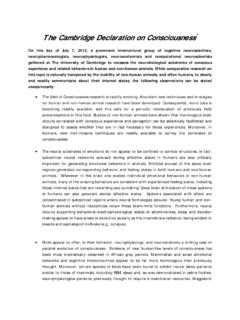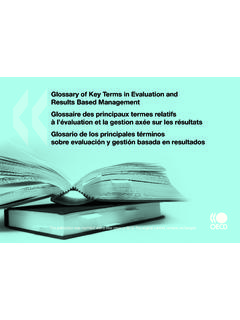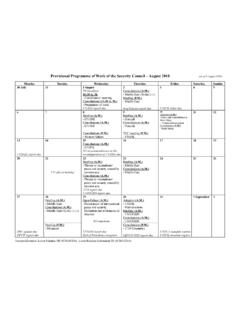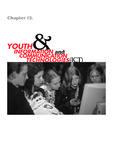Transcription of Microplastics in fisheries and aquaculture
1 FAO. ISSN 2070-7010. fisheries AND. 615. aquaculture . TECHNICAL. PAPER. Microplastics in fisheries and aquaculture : status of knowledge on their occurrence and implications for aquatic organisms and food safety 615. Microplastics in fisheries and aquaculture Status of knowledge on their occurrence and implications for aquatic organisms and food safety This report looks into the issue of Microplastics from the fisheries and aquaculture perspective. Based on existing scientific literature, a group of experts assessed the potential impact of Microplastics and related contaminants on fish consumers' health and the ecological implications for aquatic organisms. A workshop was organized with invited experts (Rome, 5-8 December 2016) who complemented the published information and carried out a risk profiling of Microplastics in aquaculture and fishery products.
2 Despite the large amount of scientific data available, there are still significant knowledge gaps, in particular regarding impacts at fish population and community level, detailed data for a proper risk assessment and implications of nanoplastics presence in the marine environment. Nonetheless, measures should be taken at international, governmental and consumer levels to undertake cost-effective ecological and seafood safety risk assessments on micro- and nanoplastics and associated polymers, to reduce plastic use and encourage the use of alternative materials, recycling and the adoption of sustainable practices in using plastics and managing plastic pollution. ISBN 978-92-5-109882-0 ISSN 2070-7010. 9 7 8 9 2 5 1 0 9 8 8 2 0. I7677EN/1 FAO. Cover design: Catoni associati Microplastics in fisheries FAO. fisheries AND. aquaculture .
3 TECHNICAL. and aquaculture PAPER. Status of knowledge on their occurrence and implications 615. for aquatic organisms and food safety Amy Lusher FAO Consultant Plymouth, United Kingdom Peter Hollman FAO Consultant Wageningen, The Netherlands and Jeremy Mendoza-Hill FAO Consultant Madrid, Spain FOOD AND AGRICULTURE ORGANIZATION OF THE UNITED NATIONS. Rome, 2017. The designations employed and the presentation of material in this information product do not imply the expression of any opinion whatsoever on the part of the Food and Agriculture Organization of the United Nations (FAO) concerning the legal or development status of any country, territory, city or area or of its authorities, or concerning the delimitation of its frontiers or boundaries. The mention of specific companies or products of manufacturers, whether or not these have been patented, does not imply that these have been endorsed or recommended by FAO in preference to others of a similar nature that are not mentioned.
4 The views expressed in this information product are those of the author(s) and do not necessarily reflect the views or policies of FAO. ISBN 978-92-5-109882-0. FAO, 2017. FAO encourages the use, reproduction and dissemination of material in this information product. Except where otherwise indicated, material may be copied, downloaded and printed for private study, research and teaching purposes, or for use in non-commercial products or services, provided that appropriate acknowledgement of FAO as the source and copyright holder is given and that FAO's endorsement of users' views, products or services is not implied in any way. All requests for translation and adaptation rights, and for resale and other commercial use rights should be made via or addressed to FAO information products are available on the FAO website ( ) and can be purchased through This publication has been printed using selected products and processes so as to ensure minimal environmental impact and to promote sustainable forest management.
5 Iii Preparation of this document One of the recommendations of the GLOBAL OCEANS ACTION SUMMIT FOR. FOOD SECURITY AND BLUE GROWTH, 22 to 25 APRIL 2014 (http://www. ) requested that the Food and Agriculture Organization of the United Nations (FAO), The International Maritime Organization (IMO) and the United Nations Environment Programme (UNEP) work together with the Group of Experts on the Scientific Aspects of Marine Environmental Protection (GESAMP1) to improve the knowledge base on Microplastics in the marine environment and provide policy advice on this topic. As a result, UNEP approached GESAMP, FAO and other partners with a proposal to contribute to the global assessment on sources, fate and impacts of Microplastics on the marine environment and resources with funding provided by the Government of Norway. FAO was requested to contribute specifically on fisheries and aquaculture ; the two main concerns were to assess the potential impact of Microplastics on consumers'.
6 Health and perception, and understand the potential consequences on fish productivity as physiological processes are likely to be affected by Microplastics (because of their occurrence and of the presence of additives and contaminants contained in the plastic). Samples collected so far and scientific literature increasingly and clearly show occurrence of Microplastics in fish and shellfish as well as in fisheries and aquaculture products. This report is meant to contribute to take stock of the scientific knowledge available, provide information on the most likely pathways in terms of sources, transport and distribution in both marine food chains and seafood value chains, and provide a framework to assess the risks that may (or not) affect commercial fish stocks and consumers. In addition, the report looks into the current practices and limitations of microplastic sampling techniques.
7 The report is based on scientific literature published in international journals, as well as expert knowledge. Amy Lusher, Peter Hollman and Jeremy Mendoza-Hill produced the first draft of the report, with the support of Natalie Welden. The draft was then discussed by a group of invited experts during a workshop held in Rome from 5 to 8 December 2016. The experts reviewed the initial draft and provided additional sections and references to produce an advanced draft that was submitted to reviewers. It is to be noted that given the high and rapid production of literature, taking stock of current knowledge on Microplastics is challenging. Therefore, this report needs to be considered as a work in progress and might require periodic updates; however, in the time being, the publication will contribute to raise awareness and outreach to fisheries and aquaculture operators, scientists and policy makers to sensitize them to the issue of Microplastics .
8 1. Joint IMO/FAO/UNESCO-IOC/UNIDO/WMO/IAEA/UN/UNE P/UNDP Group of Experts on the Scientific Aspects of Marine Environmental Protection. iv Abstract Plastic production has increased exponentially since the early 1950s and reached 322 million tonnes in 2015, this figure does not include synthetic fibres which accounted for an additional 61 million tonnes in 2015. It is expected that production of plastics will continue to increase in the foreseeable future and production levels are likely to double by 2025. Inadequate management of plastic waste has led to increased contamination of freshwater, estuarine and marine environments. It has been estimated that in 2010 between million to million tonnes of plastic waste entered the oceans. Abandoned, lost or otherwise discarded fishing gears (ALDFG) are considered the main source of plastic waste by the fisheries and aquaculture sectors, but their relative contribution is not well known at regional and global levels.
9 Microplastics are usually defined as plastic items which measure less than 5 mm in their longest dimension, this definition includes also nanoplastics which are particles less than 100 nanometres (nm) in their longest dimension. Plastic items may be manufactured within this size range (primary micro- and nanoplastics) or result from the degradation and fragmentation of larger plastic items (secondary micro- and nanoplastics). Microplastics may enter aquatic environments through different pathways and they have been reported in all environmental matrices (beaches, sediments, surface waters and water column). Ingestion of Microplastics by aquatic organisms, including species of commercial importance for fisheries and aquaculture , has been documented in laboratory and field studies. In certain field studies it has been possible to source ingested Microplastics to fisheries and aquaculture activities.
10 Microplastics contain a mixture of chemicals added during manufacture, the so-called additives, and efficiently sorb (adsorb or absorb) persistent, bioaccumulative and toxic contaminants (PBTs) from the environment. The ingestion of Microplastics by aquatic organisms and the accumulation of PBTs have been central to the perceived hazard and risk of Microplastics in the marine environment. Adverse effects of Microplastics ingestion have only been observed in aquatic organisms under laboratory conditions, usually at very high exposure concentrations that exceed present environmental concentrations by several orders of magnitude. In wild aquatic organisms Microplastics have only been observed within the gastrointestinal tract, usually in small numbers, and at present there is no evidence that Microplastics ingestion has negative effects on populations of wild and farmed aquatic organisms.















